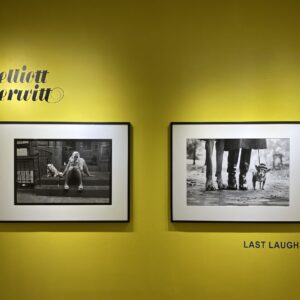JTF (just the facts): A group exhibition consisting of works by 34 photographers from 16 countries, installed on the 2nd and 3rd floors of the museum. The show was curated by Isolde Brielmaier, with assistance from Noa Wynn.
The following works are included:
- Devin Allen: 4 pigment prints, 2015
- Yolanda Andrade: 4 pigment prints, 2019
- Shoichi Aoki: 9 pigment prints, 1997, 1998, 2000
- Janette Beckman: 3 pigment prints, 1995, 1997
- Sheila Pree Bright: 5 pigment prints, 2015, 2020
- Vanessa Charlot: 4 pigment prints, 2020
- Soufian Chemcham: 5 pigment prints, 2020-2023
- Mel D. Cole: 4 pigment prints, 2020
- Martha Cooper: 4 pigment prints, 1978-1979
- Farnaz Damnabi: 3 pigment prints, 2017, 2019
- Debrani Das: 5 pigment prints, 2022, 2023
- Grace Ekpu: 6 pigment prints, 2020
- Nicholas Galanin: 2 pigment prints, 2012, 2015
- Niki Gleoudi: 3 pigment prints, 2017, 2018, 2019
- Romuald Hazoumè: 6 pigment prints, 2004
- Anthony Hernandez: 3 pigment prints, 2018, 2018-1029, 2023
- Youcef Krache: 5 pigment prints, 2014, 2016
- Lam Yik Fei: 4 pigment prints, 2019
- Corky Lee: 4 inkjet prints, 1970s, 1975, 1982, 1996
- Feng Li: 6 pigment prints, 2018, 2019
- Maha Maamoun: 1 chromogenic print, 2003
- Daido Moriyama: 3 digital chromogenic prints, 2017
- James Muriuki: 2 pigment prints, 2021, 2022
- Melissa O’Shaughnessy: 4 pigment prints, 2017
- Josué Rivas: 6 pigment prints, 2016, 2017
- Joseph Rodriguez: 5 gelatin silver prints, 1984
- Efrat Sela: 4 pigment prints, 2018, 2019
- Randa Shaath: 6 pigment prints, 2009
- Jamel Shabazz: 5 digital chromogenic prints, 1980, 1981, 2012, 2013
- Trevor Stuurman: 6 pigment prints, 2023
- Stephen Tayo: 30 pigment prints, 1 single-channel video displayed on fabric, 58 seconds, 2023,
- Alexey Titarenko: 4 toned gelatin silver prints, 1992, 1995
- Nontsikelelo Veleko: 5 pigment prints, 2003-2004
- Michael Wolf: 2 pigment prints, 2010
(Installation shots below.)
Comments/Context: To keep any artistic medium alive and relevant, its traditions must be constantly refreshed. Photographically, we’ve seen this happening in the past decade or two in nearly every genre we might name – the landscape, the portrait, the nude, even the still life – and in each case, we’re asking ourselves the same kinds of questions. What is being given attention? Who is doing the seeing? Are vantage points that were previously overlooked or marginalized now being seen? Are more global perspectives being included? How has technology changed our relationship to a given genre? And as we visually ask these questions (and many others), we’re getting a broader range of new photographic answers than we ever thought possible from these classic categories.
Street photography is clearly another genre ready for disruption and reconsideration. Its roots lie in the urban fabric of 20th century America and Europe, as seen by the likes of Henri Cartier-Bresson, Garry Winogrand, and many other now-acknowledged masters. And while an exacting definition of street photography is somewhat elusive, its visual icons have consistently turned the messy serendipity and energy of the streets into momentary compositional harmony, most often in black-and-white. Cities like New York, Los Angeles, London, and Paris have generally provided the setting for this work, with the photographers (mostly white men if we are honest) prowling the sidewalks in search of unexpected right place-right time visual synchronicity.
We Are Here: Scenes from the Streets is a diverse survey of contemporary street photography, one that actively tries to rebalance the scales of the past and to redefine the genre for a new age. It’s a sprawling sampler, intentionally more global, more inclusive, more collective, and more collaborative than we’ve seen before. And while the show does briefly reach back to late 20th century (largely to help set context), most of its time is spent nearer the present, skipping from one corner of the globe to the next and knitting the disparate photographic observations into a constantly shifting multi-cultural whole. Each included photographer is given a mini-show of a handful of works, and then thematic commonalities tie the distant realities together.
The exhibit begins on the museum’s second floor with a prelude of sorts, “An Ode to New York” that stylistically sets the street photography stage and celebrates a range of work made in the city between the 1970s and 1990s. But as a tacit corrective to the while male street photography canon of the past, these selections feature Black, Latino, Asian, and female photographers and their views of the streets, their cameras pointed at scenes and urban communities less commonly seen as subjects previously – we’re definitely not on the crowded sidewalks of Fifth Avenue anymore. Martha Cooper’s images capture the creative joy of children in the city, where small ones climb tall chain link fences, build forts with scavenged materials, and even dance on the sidewalk near graffiti-covered walls. Other pictures capture classic “decisive moments”, including a lunging dog being tugged through the air (by Jamel Shabazz), a dragon dance in Chinatown (by Corky Lee), and two basketball players leaping through the air (by Janette Beckman). But many more of the scenes are more casual and comfortable, the ordinary hanging out of city life documented in small embraces, pushed strollers, fleeting poses, passing taxis, and friendly glances from cars.
Using Melissa O’Shaughnessy’s more recent images of New York City as a kind of bridge, where echoes of blown hair and white crosswalk patterns enliven passing moments, the next section of the show makes clear that “Neighborhood and Community” need not be located in New York – they can be found almost anywhere (as seen in Algeria, Iran, Egypt, Nigeria, Israel, Greece, and India) and still be fertile ground for compelling street photography. Color stories are a reliable street photography staple, and there are several worthy examples here, featuring a silhouetted chicken near a yellow wall in the blue twilight (by Debrani Das), the interplay of red and blue of boys on a bench near a painted mural (by Farnaz Damnabi), and the joy of swimming with an inflatable pink flamingo (by Efrat Sela). Cleverly layered and momentarily overlapped compositions appear in a mirrored water reflection inserted into a city view of a family heading to the beach (by Niki Gleoudi) and a flipping boy inside a trampoline near a pair of Ferris wheels and a passing elephant (again by Debrani Das.) And when the tonalities revert back to richly monochrome black and white, more surreal ironies and symbolisms start to appear, in the matching poses of a toilet attendant and a nearby mural (by Yousef Krache), in a mannequin split across two dumpsters (also by Krache), and in an American flag jacket as seen from below (by Soufian Chemcham.)
While street photography naturally encompasses everything that might take place in the streets, including marches, rallies, and other forms of public gathering and resistance, the images in the “Protest and Advocacy” section of the show are somewhat less photographically compelling, if only because there is a clear visual repetition of crowds, posters, banners, flags, and speeches that stretches across geographic and cultural boundaries. Devin Allen’s protest images from Baltimore in 2015 are among the strongest in the group, with dramatic running figures and hands up kneeling poses amplifying the emotions of the moment. Vanessa Charlot’s images in St. Louis are similarly charged, from three generations of women posing near an American flag to a woman in a pandemic mask carrying the stars and stripes upside down. The images then jump from Mexico to Hong Kong and back through Nigeria, before returning to several spots in the United States, connecting the various activist movements together into a common visual language of protest.
Following a move upstairs to the darker and more intimate third floor galleries and catwalk spaces, the “Streetscapes and the Built Environment” section of the exhibit is anchored by three of Anthony Hernandez’ large scale screened views of Los Angeles, the sun-blasted city seen through the perforated metal mesh of bus stop shelters. His approach smartly applies a kind of approximation to the figures passing by motels and strip malls, almost like halftone printing or pixelization. But the thematic through line of this particular grouping is generally less well articulated or curated, with surveillance images by Michael Wolf hung near alley views by Daido Moriyama with little to conceptually or aesthetically connect them all together.
The final section of the show “Street Style and Self-Fashioning” crops down to street portraiture, swirling together the unadorned straightforward posing of August Sander with the boldest looks of the fashion blogs. The sampler provides a whirlwind tour of international personal identity, as seen in South Africa (by Nontsikelelo Veleko), Japan (by Shoichi Aoki), China (by Feng Li), and Senegal (by Trevor Stuurman), with colors, patterns, wigs, and nearby street architecture blended into aesthetically exuberant compositions. And in a sense, these looks ultimately connect back to images of blackmarket fuel transporters in Benin (by Romuald Hazoumè), with gasoline cans tied to their motorbikes with similar sculptural expressiveness.
Broad-gauged group shows like We Are Here succeed best when they offer a wide range of possible solutions to a given artistic problem, essentially letting viewers wrestle with dozens of alternate perspectives and solutions. This show does just that, erasing the once visible lines around the edges of street photography as a genre and allowing it to flow outward in multiple directions. In this way, its intentional diversity is its strength, even when it leads to unevenness, as it encourages us to see street photography with a much wider, more inclusive lens. Like two halves of the same whole, classic street photography can now be paired with a contemporary sibling, redefining the genre to better step into the ever changing photographic future.
Collector’s POV: Since this a large group exhibition, individual gallery representation relationships and secondary market histories are beyond the scope of the discussion. Interested collectors can likely follow up directly via artist websites and Instagram pages (linked in the sidebar).













































